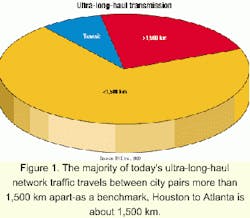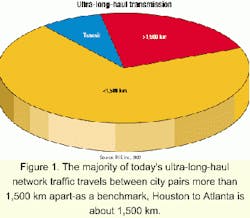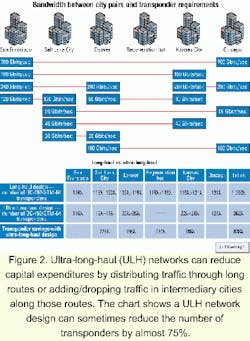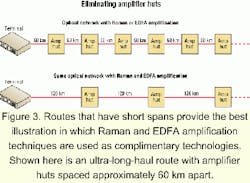The search for ultra-long-haul transmission
Service providers seek better ULH transmission options for supplying customers with high-bandwidth services at competitive prices.
PETER HUNT, Sycamore Networks
Service providers are feeling pressure to rapidly supply high-bandwidth services at increasingly competitive price points. This pressure comes to a head in the pursuit of ultra-long-haul (ULH) optical transmission. However, several options currently exist or are just on the horizon that relax the tension among carriers and service providers alike. By aggregating high-speed services into channelized, or concatenated, OC-192/STM-64 (10-Gbit/sec) wavelengths for optical transport, networks are continuing to scale in many dimensions.
ULH routes necessitate the network's ability to scale for distance. In the past, bandwidth demands were driven by the need for voice services. By their nature, the traffic was predominately local, so there was not a high demand for long-haul bandwidth. Today, the demand for cost-effective data/ Internet / video transmission has far surpassed that of voice. Major fiber network builds and terabit capacity DWDM systems are providing solutions for the bandwidth demand.
However, the distance that bandwidth services must travel is increasing. For example, who knows if the hyperlink selected is a connection in New York or New Delhi? Since you may be interconnecting with devices located across the country or across the world, the nature of this data/Internet/video traffic has placed tremendous strain on long-haul optical networks. No longer is the bandwidth distribution just hundreds of kilometers; now it is thousands of kilometers (see Figure 1).Long-haul networks deployed prior to 2000 typically could only span about 400-800 km before requiring optical-electrical-optical (OEO) regeneration. Therefore, the traffic that spans the 1,500 km would have to be electrically regenerated twice be fore reaching its final destination.
An average selling price for an OC-192 transponder is approximately $100,000. Thus, the cost in this example for additional regenerators for a 160-wave system equates to more than $64 million.
The elimination of costly OEO regenerators along the network is a major economic driver in this emerging market segment. In long-haul networks, the traffic is maintained in the optical domain, providing terabit capacities over large nationwide networks. Significant capital-expenditure reductions are associated with minimizing the need for electrical regenerators; however, several less obvious methods for increasing operational savings in a ULH network also become important:
- Space and power savings due to reductions in equipment and its associated footprint allow for significant monthly savings in operational expenditures.
- Network simplification through fewer network elements and increased software intelligence allow public carriers to operate with reduced staffing levels.
- Reduction of regeneration nodes allows for fewer truck rolls.
- The ability to provision services with the click of a mouse can increase revenue velocity.
Transmission of terabits of capacity over unregenerated routes that are thousands of kilometers poses major problems that cannot be met with conventional DWDM long-haul technology. ULH distances are achieved via emerging "hard optics" technologies such as Raman amplification, forward error correction (FEC), and dispersion-compensation components.
Equally as important, but often overlooked, are the "soft optics" technologies that allow for considerable reductions in operational costs through such tools as per-wavelength automatic power balancing and automatic network turn-up. Leveraging these technologies over OC-192/STM-64 services enables ULH networks to offer higher capacity and longer distances than traditional DWDM long-haul optical networks.
Raman Amplification. Erbium-doped fiber amplifiers (EDFAs) are a key component in the reduction of high-capacity, long-haul networks by minimizing the need for electrical regeneration equipment. However, optical networks based solely on EDFA technology are typically limited to 6-10 spans. EDFA equipment alone allows only about a 500- to 800-km route before the quality of the optical signal degrades to the point where electrical regeneration is required. This degradation is primarily due to the accumulation of noise from the EDFAs located at intermediate amplifier huts and used to boost the signal powers. Although traditional EDFA technology has continued to advance, an amplification technique called distributed Raman amplification is allowing lower-noise amplification of the optical signals, thus enabling the viability of ULH networks.
In all-optical networks, it is essential for the signals to have a sufficiently high optical signal-to-noise ratio (OSNR) at the end of the link to be error-free. Two ways to improve the signal OSNR at the conclusion of the route are to increase the signal powers launched into the fiber spans or reduce the spacing between the optical amplifiers, thus lessening noise. Neither of these methods provides an optimal, fail-proof solution.
Launching wavelengths at higher powers is not always a feasible option-due to fiber nonlinearities, the aggregate launch power of all the DWDM laser sources will cause transmission penalties. Reducing amplifier hut spacing is not always possible because of the impracticality and cost associated with building amplifier sites. For example, the facilities alone for an amplifier site can quickly exceed $500,000. First-generation ULH terrestrial and undersea systems, however, require short spacing between optical amplifiers to achieve such long distances.
Although deployment of Raman amplifiers in ULH networks is just beginning, they have quickly become accepted and taken on an integral role. Raman amplifiers provide a lower noise figure than EDFAs, thereby allowing less noise to accumulate in the system as the signals travel through multiple amplification sites. Less noise means a higher OSNR can be achieved over the route, which allows a better system bit-error rate (BER).
Distributed Raman amplification is a technique in which high-power laser energy is injected directly into the transmission fiber, allowing the fiber itself to behave as the optical amplifier. Typically, the wavelength of these laser diodes is in the 1,450-nm range to amplify C-band wavelengths. Amplification of the optical signal occurs as the wavelengths propagate through the fiber route.
First-generation ULH optical networks simply use distributed Raman amplification technology to keep the system noise level down on the OC-48 (2.5-Gbit/sec) wavelengths, allowing for an acceptable OSNR at the end of the route. Newer ULH systems-based on more cost-effective OC-192/STM-64 transmission rates-continue to use distributed Raman amplification techniques to provide high-capacity customer solutions.
FEC techniques. These techniques have been used for a number of years in such devices as modems and satellite communications to improve system robustness. In-band "weak" FEC has been used in terrestrial optical networks for improving system BER margins. However, more advanced out-of-band FEC-commonly referred to as "strong" FEC-has become an industry-accepted method for improved performance in ULH networks.
When using FEC, extra bits are electrically appended to the data stream in the DWDM transponder. These bits are encoded in an algorithm that, when decoded at the receiver, allows the receiver to recognize accumulated transmission errors and correct them. FEC, therefore, allows optical networks to operate at a much lower received OSNR than would otherwise be achievable.
Out-of-band FEC was first used on OC-48/STM-16 wavelengths in long-haul networks two years ago and is now being deployed in first-generation ULH systems that rely on OC-48/STM-16 DWDM channels. More recently, OC-192/STM-64 out-of-band FEC chipsets have become available from multiple vendors and are being used on second-generation ULH equipment that utilizes OC-192/STM-64 line rates. FEC technology continues to make advances, and these algorithms for error detection and correction allow service providers to maintain the error-free robustness demanded by their customers.
Dispersion-slope compensation. As optical-network transmission rates increase beyond 2.5 Gbits/sec to 10 Gbits/ sec and distance increases exponentially, dispersion management becomes increasingly important. Since dispersion increases linearly over distance, a major concern of ULH transport is maintaining optimal levels of dispersion across diverse transmission fibers. The correct amount and placement of dispersion-compensation components along a route is very important for maximizing transmission distances.
Innovative dispersion-compensation technologies are providing new options for controlling dispersion and providing immediate network savings. Dispersion-compensating fiber (DCF) is the predominate solution for correcting dispersion-slope impairments. DCF is a specialty fiber de signed with dispersion properties that are opposite in sign to that of the transmission fiber. Typically used at amplifier nodes, DCF corrects for most of the dispersion penalty incurred across the transmission band.
However, not all dispersion is easily corrected across the transmission band due to the mismatch in the relative slope between the transmission fiber and DCF. This disparity results in a walk-off in the accumulated dispersion that varies across the channel band and increases with distance. In a poorly designed ULH network, a small group of channels may have good transmission properties, whereas channels in another portion of the band perform poorly. In recent years, there has been a drive by the optical-component vendors to increase the tolerance of the dispersion slope to allow ULH system deployment without the limitations of dispersion-slope walk-off.
Automatic power balancing. A major limitation in long-haul transmission systems is the deviation in power among the channels resulting from the accumulation of optical-amplifier gain nonuniformities. That impacts the system in two ways: Channels that decrease in power suffer a penalty from reduced OSNR, while those channels that increase in power may degrade due to fiber nonlinearity.
There is significant variation in both output power and OSNR of the channels. Consequently, there may be an undesirable variation in BER among the DWDM channels. For ULH systems, the accumulation of gain ripple can be so great that it cannot be adequately managed. In that event, it becomes necessary to reset the channel powers to desired levels at periodic sites along the route.
The first step in problem-solving power-balancing issues is having an architecture that supports embedded hardware and software mechanisms for identifying, analyzing, and maintaining the proper optical characteristics of the system. The networks must be sophisticated enough to nondisruptively monitor the physical optical properties at all nodes throughout the network, and do that remotely through network-management software.Hardware components, such as optical spectrum analyzers, power monitors, and custom circuitry, must be integrated components of the ULH system. Intelligent network software must then be capable of automatically adjusting the operating conditions of the transponders and amplifiers within the entire network to balance the receiver OSNR levels end-to-end.
Automatic power balancing is imperative in ULH networks. Long-haul networks are challenging enough, but imagine trying to troubleshoot a system that has 160 OC-192 wavelengths and travels all-optically over 100 nodes without integrated software support.
Automatic system turn-up. Embedded software tools are also useful to quickly provision and accurately maintain optical networks. Sophisticated automatic system turn-up software algorithms allow for remote system turn-ups from cold starts and have the ability to automatically adjust the network operating conditions to allow continuous error-free operation.
Many of the systems deployed today require human intervention to measure the optical loss for each span on the route, set the pre-emphasis power levels of each wavelength, and turn-up and adjust the operating conditions of the optical amplifiers. For coast-to-coast ULH routes, the time and resources required make manual provisioning impractical. Automatic system turn-up software contributes to the bottom line by automating key turn-up and test processes, resulting in limited human error.
The economics of ULH transmission are probably best demonstrated by examining the representative route. The Table shows a typical route of a major interexchange carrier. In this route between San Francisco and Chicago, most of the circuits are expressed between the two cities. But some of the traffic is distributed to junction cities along the route. At these junction nodes (Salt Lake City, Denver, Kansas City), a smaller percentage of the wavelengths are optically added and dropped, and the services on these wavelengths are either handed off to client equipment or switched onto a spur fiber at that site (see Figure 2).Prior to the introduction of ULH networks, traffic between San Francisco and Chicago would have required regeneration, at a minimum, in Salt Lake City, Denver, Kansas City, and most likely, a node between Denver and Kansas City. That would require a total of 1,200 OC-192/STM-64 transponders.
With a single 1.6-Tbit/sec ULH system, wavelengths are terminated only in the cities where services are required, while the other wavelengths transfer through the nodes optically. In this example, only 362 OC-192/STM-64 transponders are required. At $100,000 per transponder, this capital-expenditure saving is in excess of $80 million.
As shown in the San Francisco-Chicago example, a high percentage of the service providers' traffic may need to travel thousands of kilometers. However, a smaller fraction of the circuits will only have to travel over a shorter distance along the route. Having a network with optical add/ drop nodes allows the flexibility of delivering services to both these intermediate cities as well as ultra-long-haul distances. Backhauling traffic with a separate network to intermediate cities is prohibitively expensive, since it requires a separate network. Optical add/drop nodes will continue to grow in importance as the most cost-effective solution for delivering services to intermediate cities.Distributed Raman amplification allows more bandwidth to travel longer distances without OEO regeneration and keeps the system noise at acceptably low levels. In many ULH systems, Raman amplification and EDFA technologies are used in conjunction to reduce operational overheads by as much as 25-50%. That is accomplished by the elimination of entire inline amplifier nodes.
Routes that have short spans provide the best illustration in which Raman and EDFA amplification techniques are used as complimentary technologies. For example, in a ULH route, huts may be spaced approximately 60 km apart (see Figure 3).
In traditional long-haul systems that exclusively use Raman or EDFAs, the amplification equipment is located within each of these huts to provide the inline amplification function. However, with the use of both Raman and EDFAs, some of these hut facilities may be skipped, allowing spans of 120 km. In addition to the capital-expenditure savings, which may range from $200,000 to $500,000 per hut facility, the network is simplified due to a reduced number of nodes, for which there is a corresponding operational cost savings.
Service providers need the flexibility in their networks achieved through choices in amplification techniques. Using Raman amplification, EDFAs, or some combination, service providers can attain the best cost/performance ratio.
Every day, more and more people explore the Internet. By 2005, the number of Internet users worldwide will jump to 1.17 billion, according to industry analysts. To anticipate the challenges of changing traffic demands, service providers must look to ULH networks to efficiently deliver services to their customers.
Emerging hard- and soft-optics technologies are enabling ULH networks to be one of the most reliable transport options. Designing and implementing these technologies into ULH networks is not only cost-effective but can prove positive results for a service provider's top and bottom line.
Peter Hunt is a senior product manager in the core networking division at Sycamore Networks (Chelmsford, MA). He can be reached via the company's Website, www.sycamorenet.com.




